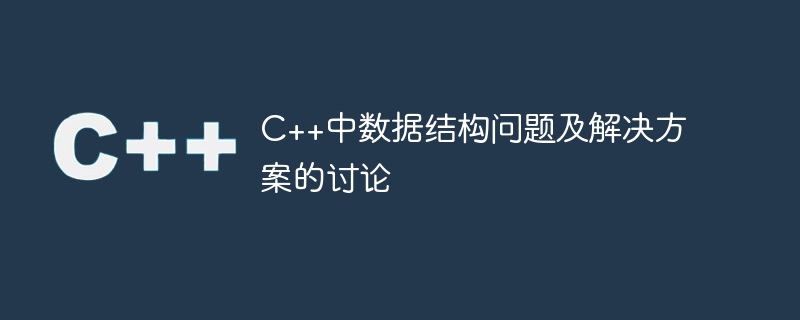

Discussion on data structure problems and solutions in C
Introduction:
In C programming, data structure is an important concept that can help us Store and manage data in an organized manner. However, when faced with complex problems, we may encounter some difficulties, and how to reasonably select and use data structures becomes a key issue. This article will introduce some common data structure problems and give corresponding solutions, as well as specific code examples.
Question 1: How to implement a dynamic array?
Solution: Vector containers can be used in C to implement dynamic arrays. Vectors can automatically resize and dynamically allocate memory as needed. The following is an example of using vector:
#include#include using namespace std; int main() { vector myArray; // 创建一个int类型的vector对象 myArray.push_back(1); // 添加元素1到数组末尾 myArray.push_back(2); // 添加元素2到数组末尾 myArray.push_back(3); // 添加元素3到数组末尾 cout << "数组元素个数:" << myArray.size() << endl; // 输出数组元素个数 cout << "数组第一个元素:" << myArray[0] << endl; // 输出数组第一个元素 cout << "数组最后一个元素:" << myArray.back() << endl; // 输出数组最后一个元素 return 0; }
Question 2: How to implement a linked list?
Solution: Pointers and structures can be used in C to implement linked lists. The following is an example of using a linked list to implement a singly linked list:
#includeusing namespace std; struct ListNode { int val; ListNode *next; // 构造函数 ListNode(int x) : val(x), next(NULL) {} }; int main() { ListNode *head = new ListNode(1); // 创建链表头节点 ListNode *node1 = new ListNode(2); // 创建第一个节点 head->next = node1; // 头节点的next指针指向第一个节点 cout << "链表元素:" << head->val << ", " << head->next->val << endl; delete head; // 释放链表节点的内存 delete node1; return 0; }
Question 3: How to implement a stack?
Solution: You can use vector or deque containers in C to implement the stack. The following is an example of using vector to implement a stack:
#include#include using namespace std; class Stack { private: vector data; public: // 入栈操作 void push(int val) { data.push_back(val); } // 出栈操作 void pop() { if (!isEmpty()) { data.pop_back(); } } // 获取栈顶元素 int top() { return data.back(); } // 判断栈是否为空 bool isEmpty() { return data.empty(); } }; int main() { Stack myStack; myStack.push(1); // 入栈操作 myStack.push(2); myStack.push(3); cout << "栈顶元素:" << myStack.top() << endl; // 获取栈顶元素 myStack.pop(); // 出栈操作 cout << "栈顶元素:" << myStack.top() << endl; return 0; }
Question 4: How to implement a queue?
Solution: The deque container can be used in C to implement the queue. The following is an example of using deque to implement a queue:
#include#include using namespace std; class Queue { private: deque data; public: // 入队操作 void enqueue(int val) { data.push_back(val); } // 出队操作 void dequeue() { if (!isEmpty()) { data.pop_front(); } } // 获取队首元素 int front() { return data.front(); } // 判断队列是否为空 bool isEmpty() { return data.empty(); } }; int main() { Queue myQueue; myQueue.enqueue(1); // 入队操作 myQueue.enqueue(2); myQueue.enqueue(3); cout << "队首元素:" << myQueue.front() << endl; // 获取队首元素 myQueue.dequeue(); // 出队操作 cout << "队首元素:" << myQueue.front() << endl; return 0; }
Conclusion:
In C programming, reasonable selection and use of data structures is the key to solving complex problems. This article introduces some common data structure problems and provides corresponding solutions, as well as specific code examples. I hope it can help readers better understand and apply data structures.
The above is the detailed content of Discussion of data structure problems and solutions in C++. For more information, please follow other related articles on the PHP Chinese website!




